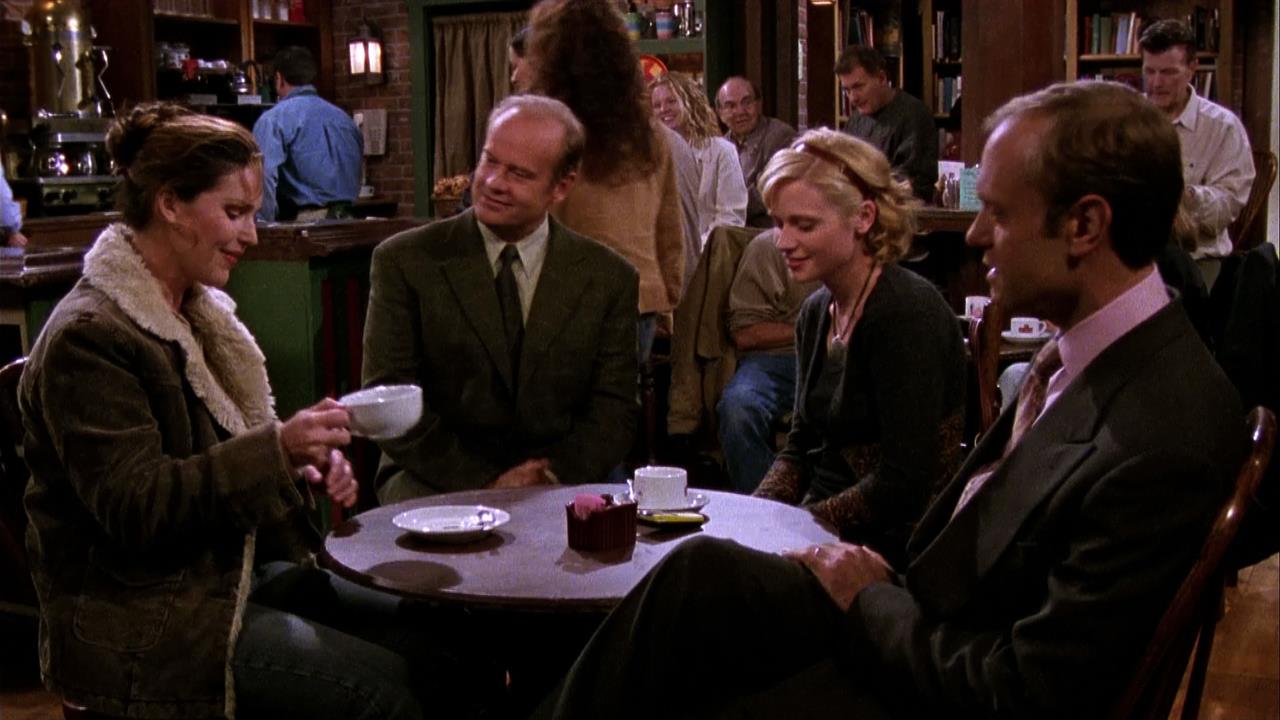
A Bit Judgmental for my Taste
I find season 10, episode 4 of Frasier, which I watched last night, an illuminating if unexpected frame through which to view Sartwell’s Political Aesthetics and its chapter on “Dead Kennedys and Black Flags: Artpolitics of Punk.” In this chapter, which explores punk music/culture “in its relation to all the arts, including music and images, film and costume, dance and festival” (12), an aesthetic philosopher writing an elite book that will be read in the academy by far less “punk” people than, say, an essay on politics and punk in Rolling Stone, Spin, or Pitchfork magazines uses punk as a case study for the aesthetics of politics. I believe this is even more of a killjoy to what punk actually was for the young people who listened and participated in it, such as my decidedly former high-school-and-early-twenties self, than if Target actually were to carry Sid Vicious’s t-shirt, a hypothetical scenario slash straw man that Sartwell builds and makes prominent use of in this chapter. I found myself wishing that Sid Vicious actually did buy said holey t-shirt from Target, just to be “ironic,” so that this point would be proven even less nuanced than it is. Sartwell invokes Bob Dylan as a predecessor of punk (113) and states that punk did not start until 1980, when most music critics, of which I was one, would say that its origins are in the ‘70’s in the New York Dolls and Iggy Pop, and probably more “obscure” bands than that. Dylan “went electric,” and continued to subvert even his folksy alternative followers’ expectations throughout his career, which he still continues to do now in his old age (refusing to accept the Nobel Prize). When counterculture became predictable, he subverted it, and pissed a lot of people off by joining what they saw as dominant, electric, non banjo-y culture. It is easy to pick on Target as the ultimate appropriator of rebellious punk rock culture, and to point derisively toward people who would buy such a shirt. I agree that Bob Dylan and also Rage Against The Machine, which Sartwell invokes, are conspicuously participating in the political realm. But what about punk, hardcore bands like Glassjaw and the Bled, Atreyu—what political statement are they trying to make with their clothes? They’re not. They’re making an emotional statement/connection, which Sartwell identifies as tribal and that is one point with which I agree (121), and their fans and the, to quote an episode of South Park, “non-conforming conformists” who follow them, dress like each other and act like each other at their shows, may be participating in a form of counter-cultural behavior but it is precisely that culture which they counter which also unites them.
Counter-culture would not even exist if there was no culture for it to counter. Its very existence is based off of defining itself by what it is not. Take, for instance, the following dialogue from the aforementioned, decidedly non-punk-rock and non-counter-culture show, Frasier. Zooey Deschnel plays a twenty-something cousin to Roz whose counter-cultural attitudes are infuriating to the lame, upper-class, opera-attending, art commissioning snob (yet endearing at times) buffoon, Frasier.
“Frasier: Oh, yes, of course. So how are you enjoying Seattle?
Jen: Well, I’ve been living in London, so Seattle seems a little lame. No offense.
Frasier: Oh, none taken. So you like London?
Jen: Not really. It’s like a parody of itself.
Frasier: How so?
Jen: Oh, you know, double decker buses, bobbies, little pubs. It’s like EPCOT but even fakier. So I bailed. Went and spent some time in Florence.
Frasier: Ah, Firenze. How is she?
Jen: I gotta say, Florence is over. It was probably cool, before all the Americans found out about it.
Frasier: You mean three hundred years ago?
Jen: Exactly. That’s why I’m going to Vietnam. Americans have never even heard of it.”

This scene allows the audience to laugh at Frasier for pompously referring to Firenze as “she” but also landing the joke on Jen, who wants to go to Vietnam simply because Americans, of whom she is one, “have never even heard of it” when of course people (older and more informed about history than she) did. For the punchline to work (which I find funny but which I realize is not “high art” or aesthetic of comedy but a decidedly sugarcoated, suburban, mainstream cultural type of comedy—but so what?), both the mainstream and the counterculture, the aesthetic and the inaesthetic, are laughed at.
The countering culture for the sake of countering culture is further exhibited when Frasier, the stand-in for the aesthetic elite, exclaims, “No! I find her cousin Jen just a bit judgmental for my taste. Yesterday she told me my show was bourgeois. I pointed out that anything that had mass appeal could be said to be bourgeois. She then said that my argument was bourgeois. Which I found to be jejeune.”
“People in their twenties are always like that,” Niles replies in an attempt to subdue his brother’s brash anger, invoking Sartwell’s statement at the end of this chapter: “Punk, after all, is older now than rock music was when punk was started” (127). If I wanted to appear non bourgeois, non suburban and edgier, I would quote Mitch Hedberg. But I am in my thirties, and am moving on and flipping not just repeating the past like Dylan, or so I think at least. Perhaps, like Sartwell states, I am “grown up and out of” my “nihilistic phase,” I have “become Fugazi”—whatever that means. I happen to like Fugazi, and find Sartwell’s “Dead Kennedys and Black Flags” needlessly “judgmental for my taste.”

